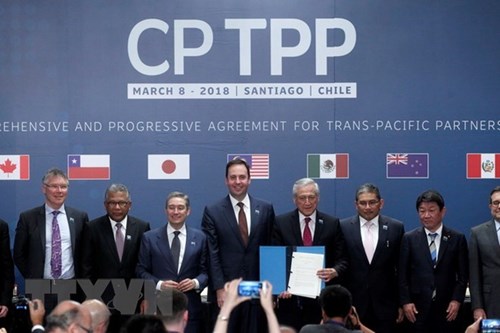This is considered a move towards progressive, open and equal trade, without the threat of trade wars.
The signing of the CP TPP has delivered a strong message against protectionism, which is emerging across the world as a barrier to global trade growth.
The new deal also marks the endless efforts of the remaining 11 member countries to revive the TPP.
    |
 |
|
Representatives of countries joined the signing ceremony of the Comprehensive and Progressive Agreement for Trans-Pacific Partnership (CP TPP) in Santiago on March 8 |
Japanese Minister of State for Economic and Fiscal Policy Toshimitsu Motegi described the CP TPP as a historic achievement that creates free and fair rules in Asia-Pacific.
The deal not only benefits member countries but also creates new momentum for regional economic-trade cooperation and connection.
Many leaders from the 11 CP TPP nations have welcomed the pact as a clear message of support for free trade and multilateralism.
Chilean President Michelle Bachelet declared that the signing of the CP TPP is a commitment to global integration and a strong signal against protectionism. It is also an ambitious and strategic multilateral cooperation deal in the context of globalization.
Covering 500 million people on both sides of the Pacific Ocean, the pact represents a new vision for global trade as the US imposes steel and aluminum tariffs on even some of its closest allies.
The New York Times quoted Wendy Cutler, a former United States trade negotiator who worked on the Trans-Pacific Partnership as saying it’s hard for the US to ignore rules that other countries have agreed and must look carefully at these rules.
Meanwhile, the Wall Street Journal posted a story titled “In America’s Absence, the TPP Goes On”, highlighting the survival of the TPP, now CP TPP or TPP – 11, which will be a boon to traders in Australia, Brunei, Canada, Chile, Japan, Malaysia, Mexico, New Zealand, Peru, Singapore and Vietnam.
The CP TPP is also the latest illustration that other countries are accelerating efforts to conclude trade deals.
The CP TPP was inked at a ceremony chaired by Chilean President Micelle Bachelet in Chile on March 8, 2018.
Trade ministers of 11 countries participating in the trade pact, namely Australia, Brunei, Canada, Malaysia, Mexico, Japan, New Zealand, Peru, Singapore and Vietnam, attended the event.
The ambitious deal came after the US pulled out of the TPP agreement last year. It sets high criteria in numerous fields, including labor, the environment, intellectual property, digital economy and cyber security.
The pact will create one of the world’s largest free trade blocs with a combined market of 499 million people and GDP of about USD 10.1 trillion, accounting for 13.5 percent of global GDP.
Source: VNA